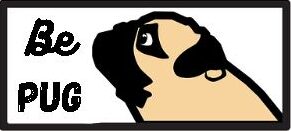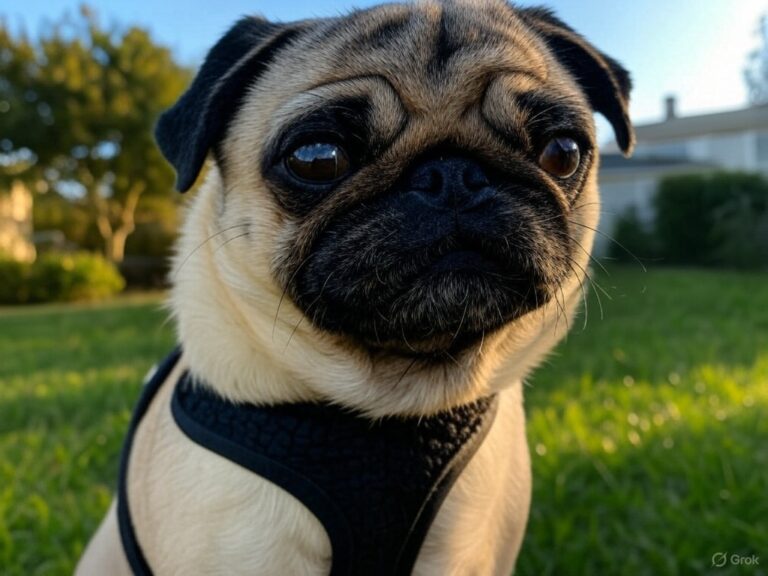Best Harness for Pugs – Everyday Comfort and Control

Disclosure: This post contains affiliate links. As an Amazon Associate, I earn from qualifying purchases—at no extra cost to you.
Last Updated: September 10, 2025
A good harness makes walks safer and more enjoyable for your pug. Because of their short necks and flat faces, collars can put too much pressure on the airway. A harness spreads that pressure across the chest and shoulders, giving your pug more comfort and you more control. The right choice depends on your pug’s stage of life—whether you’re training a puppy, dealing with a puller, or just looking for everyday comfort.
👉 Building your pug’s starter kit? Our pug accessories guide covers the daily gear that complements a safe harness.
💰 Check Price & Availability
We’ve chosen three pug-friendly harnesses that fit different needs—puppies, pullers, and daily comfort.
View on Amazon – Voyager Step-In Air Dog Harness – Best for Pug Puppies
View on Amazon – Rabbitgoo No-Pull Dog Harness – Best for Pugs That Pull
View on Amazon – PoyPet No-Pull Dog Harness – Best Everyday Comfort
📋 Quick-View Comparison List
🐶 Voyager Step-In Air Dog Harness
⚡ Strengths: Soft mesh, lightweight, easy to put on
💤 Best For: Pug puppies, short walks, first harness training
💲 Price Range: Affordable
⚠️ Limitations: Not strong enough for heavy pullers
🐶 Rabbitgoo No-Pull Dog Harness
⚡ Strengths: Front clip for no-pull training, reflective straps, secure fit
💤 Best For: Adult pugs that pull, training walks, evening outings
💲 Price Range: Mid-Range
⚠️ Limitations: Bulky for very small pugs
🐶 PoyPet No-Pull Dog Harness
⚡ Strengths: Padded chest, breathable mesh, adjustable straps
💤 Best For: Everyday walks, car rides, comfort-focused use
💲 Price Range: Mid-Range
⚠️ Limitations: Straps can loosen if not checked regularly
🔍 Comfort & Fit
Pugs need harnesses that avoid neck pressure. The Voyager is soft and light, perfect for puppies learning to walk. The Rabbitgoo has padding and a front clip that helps manage pulling. The PoyPet gives a balanced fit, combining comfort and control for daily outings.
👉 To make sure your pug’s harness fits just right, see our guide on how to measure a pug for a harness.
🔍 Safety & Durability
Durability matters if your pug pulls. The Rabbitgoo stands out with reinforced straps and reflective stitching. The Voyager is lightweight and best for puppy walks. The PoyPet offers everyday sturdiness while staying gentle on your pug’s skin.
👉 If you’re unsure about harness safety, our guide on chest harnesses explains the risks and benefits for pugs.
🔍 Size & Adjustability
The Voyager adjusts easily to keep up with puppy growth. The Rabbitgoo is sized for adult pugs with a solid build. The PoyPet includes multiple straps for a tailored fit, no matter your pug’s shape.
🔍 Best Match for Pug Owners
Choose the Voyager if you’re training a puppy on short walks. Go with the Rabbitgoo if your adult pug pulls hard on the leash. Pick the PoyPet if you want a comfortable, all-around harness for daily use.
👉 For owners who want more durability and control, check our guide to the best tactical harnesses for dogs.
📦 Voyager Step-In Air Dog Harness – Best for Pug Puppies
This soft mesh harness slips on easily and feels light, so puppies accept it quickly. It’s breathable and comfortable, though not strong enough for dogs that pull.
📦 Rabbitgoo No-Pull Dog Harness – Best for Pugs That Pull
With a front clip to discourage pulling, the Rabbitgoo helps make training smoother. Reflective straps add safety for evening walks. It can feel bulky on small pups but is great for adult pugs.
📦 PoyPet No-Pull Dog Harness – Best Everyday Comfort
The PoyPet blends padding, breathable mesh, and adjustability for daily use. It’s comfortable for long walks and quick trips. Just check the straps now and then to be sure they stay snug.
🟢 FAQs
Q: Should pugs wear a collar or harness?
A: A harness is the safer option for walks, as it avoids pressure on the neck. Collars are better for ID tags and light wear.
Q: What’s the best harness for a pug puppy?
A: The Voyager Step-In Air Harness is gentle and simple, making it ideal for puppies.
Q: What size harness fits a pug?
A: Most adult pugs fit into small or medium harnesses. Measure your pug’s chest girth to be sure.
Q: What’s the best harness for pugs that pull?
A: A no-pull harness like the Rabbitgoo works best for strong pullers and makes training easier.
✅ Conclusion
The best harness for pugs depends on their needs. The Voyager is a safe starter for puppies. The Rabbitgoo is the right pick for adult pugs that pull. The PoyPet gives a balance of comfort and durability for everyday use.
Harnesses keep pugs safe and breathing comfortably, which is why they’re recommended over collars for daily walks. The right fit makes every outing more enjoyable for both you and your pug.






